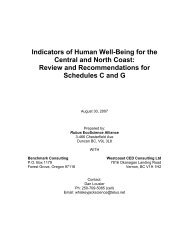Final report - Integrated Land Management Bureau
Final report - Integrated Land Management Bureau
Final report - Integrated Land Management Bureau
Create successful ePaper yourself
Turn your PDF publications into a flip-book with our unique Google optimized e-Paper software.
Transportation Assessment of the North and Central Coast of BC<br />
together hobbling economic opportunities and investment decisions. The<br />
communities of LRMP Plan area need to improve their transportation system in<br />
order to sustain and grow the regional economy.<br />
Transportation Setting<br />
The transportation system of the Central and North Coast LRMP Plan area<br />
encompasses air, road, water and rail modes of transport, with two principal<br />
and distinct functions:<br />
• a national and regional economically strategic role in supporting exports<br />
and imports through its two major ports, Prince Rupert and Kitimat, as<br />
well as the export of resources from various points of productions; and,<br />
• the provision of basic necessities and passenger transportation within<br />
and to/from the region.<br />
The system includes the following array of infrastructure and activity:<br />
• Prince Rupert and Terrace regional airport hubs, several minor airports<br />
and landing strips, as well as docks to accommodate float planes;<br />
• Scheduled air service to/from Prince Rupert, Hartley Bay, Lax<br />
Kw’alaams, Kitkatla, Bella Coola, Bella Bella, Klemtu, Port Hardy and<br />
Terrace/Kitimat;<br />
• Several fixed wing and helicopter companies providing charter service<br />
and medevac throughout the entire region;<br />
• BC Ferries’ routes 10, 11 and 40;<br />
• Two major and 13+ regional or local ports;<br />
• Highways 16, 20 and 37;<br />
• CN Rail line to Prince Rupert;<br />
• Private ferries and water taxis;<br />
• Cruise ships calling on Prince Rupert; and,<br />
• Commercial and charter vessels serving commercial fishing and<br />
processing, barges carrying supplies and export resources, and log<br />
booms.<br />
Access to and from the communities of the Central and North Coast is made<br />
challenging by great distances (and therefore high travel costs), and unreliable<br />
weather and visibility, especially during the winter months. Most communities<br />
are heavily dependent on the BC Ferries system, and a system of barges and<br />
scheduled or chartered aircraft.<br />
Chisholm Consulting ii

















